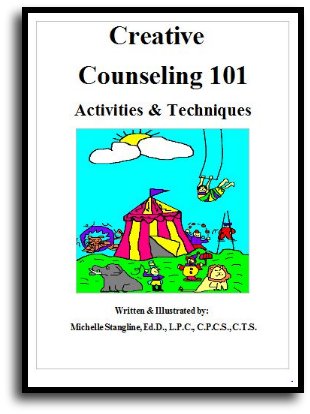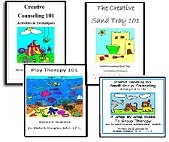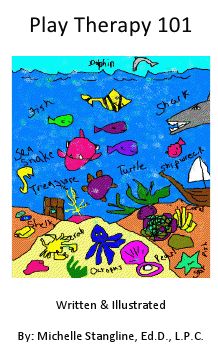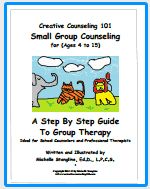Sand Tray Therapy for Final Exam Project (Rational Emotive Behavior Therapy)--Student #2
by Sand Tray Therapy Student
Using Rational Emotive Behavior Therapy in Sandtray Therapy to Help People Suffering With Depression
Introduction
This white paper discusses how Rational Emotive Behavior Therapy (REBT), from the cognitive behavior theoretical framework, can be useful for treating people with depression and preventing the recurrence of suicidal behavior in people who have recently attempted suicide or self-harmed. In general, treatment strategies for cognitive behavioral therapy (CBT) incorporate higher order thought processes by directing a client’s attention in a deliberate manner. The basic goal of REBT is to teach clients how to change their dysfunctional emotions and behaviors into healthy ones and correct any thought patterns that are problematic.
The cognitive behavioral approach focuses on clients’ experiences in the present instead of focusing on their past. The emphasis is on clients acting on a self-defeating view of themselves and their world and learning effective ways to dispute self-defeating thinking. Sandtray therapy focuses on clients being in the “here and now.” The opportunity for self-expression and self-exploration through sandtray therapy coupled with unconditional positive regard and the belief that people have the capacity to change their cognitions, behaviors, and emotions opens the door for changing the lives of these people who are in dire need of help. Adding an element of hope by giving clients the opportunity to explore their reasons for living can give clients a better outlook on life and potentially save the lives of depressed people.
History
The U.S. Surgeon General has identified suicide attempts as a public health problem. Nearly 9% of adolescents in the U.S. report a suicide attempt in a given year. The third leading cause of death for adolescents in the U.S. is suicide. In any year, about 10 percent of the U.S. population will suffer from a serious depression (Knaus, 2006). Depression is currently the number one disability for women.
It is vital that mental health professionals help people who recently attempted suicide or engaged in self-injury because these behaviors are predictive of future suicidal behavior. The risk of repeating a suicide attempt is highest in the first three to six months after an attempt. Adolescents with depressive disorders and a history of suicidal behavior are a particularly high risk group for repeated and completed suicide. Research has shown that CBT considerably alleviates symptoms of depression.
The use of cognitive behavioral therapy in preventing suicide is substantiated in a research study called Treatment of Adolescent Suicide Attempters (TASA) that was designed to prevent reoccurrence of suicide attempts in depressed and suicidal adolescents (Brent, et. al. 2009). It was based on reducing the severity of three established risk factors for suicidal behavior which are depression, suicidal ideation, and impulsivity. The primary goals of this intervention are to reduce suicidal risk factors, enhance coping, and to prevent suicidal behavior. Adolescents who reduce suicidal risk factors, enhance coping, and to prevent suicidal behavior. Adolescents who make suicide attempts, or who have acute or persistent suicide ideation, typically have multiple psychiatric and environmental problems (Bridge, Goldstein, and Brent, 2006). Even though this study was used for adolescents, the sandtray experience could be expanded to include adults, also.
Your Perspective
Cognitive techniques call for responses that involve cognitive and abstract thinking. The goal is for clients to figure out for themselves the connection between their thinking and the ways they act and feel. Sandtray therapy has an expressive and projective nature and would enhance the opportunity to make these discoveries.
Sharing the details of the suicide attempt or suicidal crisis (and circumstances surrounding it) facilitates rapport building with a therapist, gives clients the opportunity to feel understood, and helps patients engage in treatment. This intervention also facilitates the development of a conceptualization of patients’ suicidality and assessment of future risk.
There are three components that trigger peoples’ depression. First, clients hold a negative view of themselves. They blame themselves for any setbacks because they are inadequate and have convinced themselves that they lack qualities that will bring them happiness. Second, they tend to interpret their experiences in a negative manner. Third, clients often have a gloomy vision and projection of their future. They expect present difficulties to continue and anticipate only failure in the future.
A central focus of using cognitive behavior therapy for suicide prevention is the identification of proximal risk factors and stressors, including emotional, cognitive, behavioral, and family processes active just prior to and following the adolescent’s suicide attempt or recent suicidal crisis. These processes include deficits in the clients’ abilities or motivations to cope with suicidal crises. For example, such deficits may include the inability to regulate emotions, the inability to resolve problems, the inability to tolerate distress, the inability to address negative thoughts or beliefs such as hopelessness or worthlessness. These risk factors are identified by asking clients to use the A-B-C Framework in REBT to explain the sequence of events in their lives that have led to their suicidal or self-harming behavior and their reactions to these events that led to the suicidal crisis.
Plus and Minus
Some of the premises for REBT is that people are born with a predisposition to be happy, self-preserving, thinking and verbalizing, loving, in communion with others, and working towards growth and self-actualization. REBT can help people to accept themselves and realize that even though they are fallible and will continue making mistakes, they can live peacefully.
The REBT approach is directive. This makes the therapy beneficial because the clients are in a state of crisis so need this direction. They need to have their irrational beliefs and negative thinking pointed out to them. However, the therapist needs to be careful to avoid imposing their own philosophy of life on their clients as they search for clients’ thinking mistakes.
REBT has many concepts to grasp. It takes some time to learn this therapy, both from a therapist and client point of view. The average time for a person to complete REBT is one year. In addition, it takes time for clients to understand the concepts of the A-B-C Framework and realize what irrational beliefs they hold about themselves. This directive approach may neglect the role that feelings play in the therapeutic process.
Clients may come from a particular culture that holds certain beliefs and values that the therapist may not be familiar with. The therapist must understand and respect every client’s world. Some cultures may be looking for the therapist to decide for them the appropriate ways to solve problems instead of working towards solving them on their own.
Limitations
Clients with depression often have feelings of shame. It is difficult for these clients to be hopeful and be able to identify anything positive about themselves or their lives.
Clients are living in invalidating environments. If they continue to hear bad messages from their parents or others in their household so it becomes more difficult for them to develop the ability to identify and examine their irrational beliefs.
Dangers
The biggest danger in sandtray therapy is not allowing clients to talk about the world that they have created and the therapist making interpretations that are inaccurate. With REBT being directive and people with depression being more emotionally sensitive, the therapist needs to be careful to be encouraging and not too critical when they begin to dispute the clients’ cognitive distortions.
Executive Summary
The U.S. Surgeon General has identified suicide attempts as a public health problem. Research has shown that CBT considerably alleviates symptoms of depression. Specifically, Rational Emotive Behavioral Therapy (REBT) methods can be beneficially directed toward addressing irrationalities in depressive thinking.
Using sandtray therapy, a therapist can teach clients the A-B-C Framework of REBT, and direct them to describe the “frames in the film” that depict scenes of the sequence of events that led to the suicide attempt or self-harming behavior, the details of the actual event, and events that followed the destructive behavior. The therapist identifies risk factors such as the inability to regulate emotions, the inability to resolve problems, the inability to tolerate distress, and the inability to address negative thoughts or beliefs such as hopelessness or worthlessness.
Sandtray therapy focuses on clients being in the “here and now.” The opportunity for self-expression and self-exploration through sandtray therapy coupled with unconditional positive regard and the belief that people have the capacity to change their cognitions, behaviors, and emotions opens the door for changing the lives of these people who are in dire need of help. Directing the depressed clients to explore their reasons for living can help to alleviate their distress.
How to Use The Sand Tray for Sand Tray Therapy Link:
More Ideas on Sand Tray Therapy
For more free ideas on creative therapy visit the link below:
Creative Counseling 101.com Home
Disclaimer: This website and its content is intended for trained licensed mental health professionals and school certified mental health professionals to use for their clients / students at their own discretion.
*If you ignore the disclaimer above are using these techniques on yourself and you feel any discomfort or upset it is highly suggested that you seek out a licensed mental health professional immediately.
"Beyond Art Therapy" is the concept from Dr. Stangline that combines all creative fields in therapy. It is not the traditional "art therapy" but goes beyond to include sand tray therapy, play therapy, mindfulness, meditation, color therapy, cognitive behavioral therapy, and a vast majority of other therapies.
For any other type of mental health emergency call your local 911 / Police Number immediately.
Dr. Stangline does not offer advice / suggestions to anyone who is not a professional mental health provider, or a student who is studying this field and has questions about mental health programs of study.
See our Exciting Selection of eBooks:
Award Winning:
Creative Counseling 101 eBook
Our Best Seller!

Step By Step Therapy:
Learn how to be a more Creative Therapist with the Book that started it all!
- Graduate School Counseling book used by hundreds of graduate counseling students!
- Includes full color reproducible worksheets with most activities.
- Winner of the Counselor Writer of the Year Award, 2011, Georgia Regional Award
Download Your Copy Today Only $39.95:
See Creative Counseling 101 eBook Information Here:
Get the Set
of all four
eBooks for only $98.95:
An incredible collection of how to do therapy eBooks!
A $159.80 Value,
You Save Over $60!

Get your complete set of the Creative Counseling 101.com eBooks by Dr. Michelle Stangline for only $98.95, that's less than $25.00 per eBook (Regular Price is $39.95 for each eBook.).
Your complete set includes:
- Creative Counseling 101
- Creative Group Counseling 101
- Creative Play Therapy 101
- Creative Sand Tray 101
For more information click the link below:
See Complete Set of eBooks For Sale Here:
New!!! "Beyond Art Therapy" 101 eBook
Over 300 pages of Beyond Art Therapy activities and techniques. Learn what I teach graduate counseling students!
See the link below for more information.
Only $39.95

See More Invividual eBooks For Sale:
Sand Tray Therapy 101 eBook:
Learn how to do Sand Tray Therapy or enhance your skills.

Play Therapy 101 eBook
Learn how to do play therapy or enhance your skills.

Small Group Counseling eBook For Sale:
Learn how to do creative group therapy and enhance your skills.

School Counselor Guidance Lesson & Social Stories eBook for sale:
Get a year's worth of school counselor guidance lessons with "Creative Warm & Fuzzy Classroom Guidance Lessons eBook". Introduce your students to the "Warm & Fuzzy Way". Click the link below for more information:
Warm & Fuzzy School Counselor Guidance Lessons eBook
